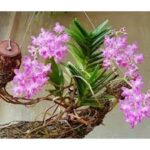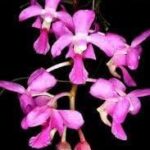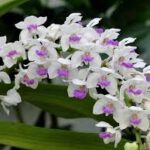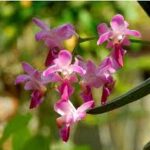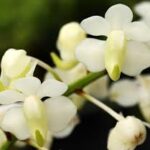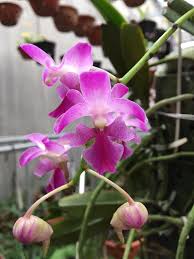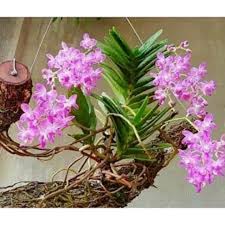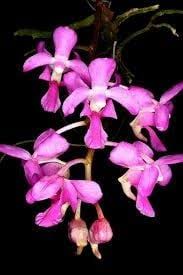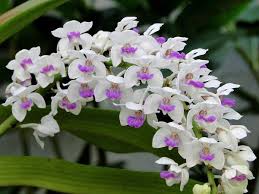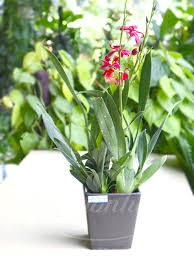
**1. Overview of Sato Cymbidium Varieties**
Sato Cymbidium orchids are admired for their diverse and captivating varieties, each offering unique characteristics in terms of shape and color. Understanding these differences can help enthusiasts and growers identify specific types, select the best varieties for their collections, and appreciate the nuances that make each one special. The variations in petal shape, flower structure, and coloration contribute to a rich and colorful range of blooms that can enhance any indoor or garden setting.
**2. Shape Differences in Sato Cymbidium Flowers**
The shape of Sato Cymbidium flowers is one of the primary distinguishing factors between different varieties. While they all share the basic orchid structure, which consists of three sepals, two petals, and a distinctive lip or labellum, subtle variations set them apart.
– **Rounded Petals vs. Pointed Petals:** Some Sato Cymbidium varieties feature rounded petals that give the flowers a softer, more delicate appearance. These rounded blooms are often associated with classic, traditional types. On the other hand, there are varieties with pointed petals that create a sharper, more striking visual effect. The pointed varieties often look more exotic and bold, making them a favorite for those who prefer a dramatic flair.
– **Lip Shape and Size:** The lip or labellum is the centerpiece of an orchid flower, and in Sato Cymbidium, it can vary significantly. Some varieties have a broad, ruffled lip that stands out, while others feature a smaller, more subtle lip. The shape and curvature of the lip can influence the overall aesthetic of the flower, ranging from elegant and understated to bold and flamboyant.
– **Flower Arrangement:** The way flowers are arranged on the spike can also differ between varieties. Some Sato Cymbidiums have a cascading arrangement where the flowers gracefully arch downwards, while others have a more upright, compact formation. The cascading types are often used in hanging displays or as focal points in floral arrangements, while the upright varieties are ideal for neat, symmetrical displays.
**3. Color Variations in Sato Cymbidium Orchids**
Color is another key aspect that helps in differentiating Sato Cymbidium varieties. These orchids are known for their vibrant and diverse color palette, which includes everything from soft pastels to deep, rich hues.
– **Classic Whites and Creams:** Many traditional Sato Cymbidium varieties are recognized by their classic white or cream-colored petals, which exude simplicity and elegance. These colors are often chosen for special occasions like weddings due to their clean, pure look. They may also feature subtle color accents on the lip, such as light pink or yellow, adding a touch of warmth without overpowering the delicate beauty.
– **Bold and Bright Colors:** For those looking for more vibrant options, there are Sato Cymbidium varieties that come in shades of red, orange, and even bright yellow. These bold-colored varieties are perfect for adding a burst of color to any indoor space or garden. The vibrant tones can range from solid colors to flowers with a gradient effect, where the intensity of the color changes from the center of the petal to the edges, creating a striking visual.
– **Soft Pastels:** Pastel-colored Sato Cymbidiums are favored for their soft, calming appearance. Varieties in shades of light pink, lavender, and peach can provide a gentle, soothing aesthetic that fits well in both contemporary and traditional settings. These colors often evoke a sense of calm and serenity, making them a popular choice for indoor decor and floral arrangements intended to create a relaxed atmosphere.
**4. Unique Patterns and Markings**
Aside from color, many Sato Cymbidium varieties have unique patterns and markings that further distinguish them from each other. These can include speckles, stripes, and color splashes that give each flower a distinct look.
– **Speckled and Spotted Varieties:** Some Sato Cymbidiums have petals adorned with tiny speckles or spots, which can vary in color. These patterns may be evenly distributed or concentrated around the center of the flower, adding depth and texture to the overall appearance. Spotted varieties are often considered more exotic and can be a focal point in any collection.
– **Striped Petals:** Stripes can also be a feature of certain Sato Cymbidium varieties. The stripes usually run vertically along the petals and can be subtle or pronounced, depending on the variety. These stripes often contrast with the base color, creating a striking, eye-catching design that makes the flower stand out.
– **Color-Accented Lips:** The lip or labellum of the Sato Cymbidium can sometimes be a different color than the petals, adding an extra layer of contrast. For example, a variety may have soft white petals with a bright purple or red lip, which immediately draws attention to the center of the flower. This contrast can highlight the intricate details of the lip, including its texture and shape.
In the following sections, we will further explore the specific varieties of Sato Cymbidium, highlighting popular types and their distinctive features. We will also provide tips on how to select and care for these orchids based on their visual characteristics.
### Differentiating Sato Cymbidium Varieties by Shape and Color
**5. Popular Sato Cymbidium Varieties and Their Unique Features**
To effectively differentiate between the various Sato Cymbidium varieties, it’s helpful to focus on some popular types, examining their specific shape and color characteristics. Here are a few notable varieties:
– **Cymbidium ensifolium:** This variety is distinguished by its narrow, sword-shaped leaves and elongated flower spikes. The flowers typically have a yellow-green color with prominent red or maroon markings on the lips. The petals are somewhat pointed and can have a delicate, airy appearance, making them ideal for garden settings where a more natural look is desired.
– **Cymbidium goeringii:** Known for its compact growth habit, this variety features smaller, fragrant flowers that can range in color from pale green to light pink. The petals are rounded and often have subtle markings. This variety is excellent for indoor growing due to its manageable size and lovely scent, making it a delightful addition to any space.
– **Cymbidium hybrid (e.g., ‘Golden Elf’):** Hybrid varieties, like ‘Golden Elf,’ are popular for their stunning blooms. This specific hybrid showcases bright yellow flowers with a striking, broad lip that may be accented with darker yellow or orange hues. The petals are broader and have a more rounded shape, giving them a plush, luxurious appearance. This variety is a favorite for floral arrangements due to its bold color and shape.
– **Cymbidium canaliculatum:** This variety is known for its unique, flat-lipped flowers that often feature a blend of green and yellow tones. The petals are narrow and can have a slightly ruffled edge, providing a distinctive look that sets them apart from other types. The combination of colors and shapes makes this variety a captivating choice for collectors.
**6. Seasonal Changes in Flower Appearance**
Sato Cymbidium orchids can also exhibit seasonal changes that affect their appearance. Understanding these variations can help in distinguishing between different varieties at different times of the year.
– **Winter Blooms:** During the winter months, many Sato Cymbidiums tend to produce flowers that may have a slightly deeper color intensity. This phenomenon can be attributed to the lower light conditions typical of winter, which can enhance the vibrancy of the blooms. For example, a pink flower might appear more saturated than it would during the summer months, making it an exciting time to observe changes in your orchids.
– **Summer Blooms:** In the warmer months, the same varieties may show lighter or more pastel hues as they respond to increased light exposure. Petal shapes can also appear more expansive due to the warmer temperatures, resulting in blooms that may seem fuller or more open than during the winter.
– **Impact of Light on Color:** The quality of light plays a significant role in the color of Sato Cymbidium flowers. Varieties that receive bright, indirect sunlight often exhibit brighter and more vivid colors. Conversely, those that receive lower light levels may have more muted tones. Adjusting the light exposure based on the seasonal changes can help enhance the appearance of your orchids.
**7. Importance of Flower Size and Spike Length**
Another critical factor to consider when distinguishing between Sato Cymbidium varieties is the size of the flowers and the length of the flower spikes.
– **Flower Size:** Sato Cymbidium flowers can vary significantly in size, from petite blooms that are only a few inches across to larger varieties that can measure up to five or six inches in diameter. For instance, larger varieties often feature broader petals that create a more substantial visual impact, while smaller varieties tend to have a more delicate appearance. When comparing varieties, it’s essential to observe the size of both the individual flowers and the overall plant.
– **Spike Length:** The height of the flower spike also varies among Sato Cymbidium varieties. Some types produce tall, upright spikes that can reach heights of two feet or more, displaying flowers in a vertical arrangement that can create a dramatic focal point. In contrast, other varieties may have shorter spikes, which keep the flowers closer to the foliage and create a more compact appearance. Understanding these height differences can help in selecting the right Sato Cymbidium for your space.
**8. Cultural and Environmental Influences on Appearance**
The environment in which Sato Cymbidium orchids are grown can significantly influence their shape and color, highlighting the importance of proper care and conditions.
– **Watering Practices:** Overwatering or underwatering can lead to poor health in orchids, affecting the shape and quality of the flowers. For example, overwatering can cause the petals to appear limp or discolored, while underwatering may lead to shriveled blooms. Understanding the specific water needs of each variety will help maintain optimal health and vibrant flowers.
– **Nutrient Availability:** The type and amount of fertilizer used can also impact the appearance of Sato Cymbidium flowers. Providing the right nutrients at the appropriate times can enhance flower size and color intensity. For example, a high phosphorus fertilizer can promote blooming and improve the vibrancy of colors, while nitrogen-rich fertilizers can encourage healthy leaf growth. It’s important to choose fertilizers that are specifically formulated for orchids to ensure the best results.
– **Temperature and Humidity:** Different Sato Cymbidium varieties may thrive in varying temperature and humidity conditions. For instance, some varieties prefer cooler temperatures, while others may do well in warmer environments. The right balance of humidity is also crucial; higher humidity levels can lead to more vibrant colors and healthier blooms. Monitoring temperature and humidity levels can help create an environment that suits the specific needs of each variety.
**9. Collecting and Displaying Sato Cymbidium Varieties**
Once you’ve identified the different varieties of Sato Cymbidium by their shape and color, you may want to consider how to best display them to showcase their unique features.
– **Creating a Cohesive Display:** When arranging Sato Cymbidium orchids, consider grouping varieties that complement each other in terms of color and shape. For example, pairing a tall, striking yellow variety with a more compact pink type can create an eye-catching contrast. Displaying them together can highlight their differences while creating a harmonious visual impact.
– **Using Decorative Containers:** The choice of containers can also affect how the orchids are perceived. Opt for pots that enhance the colors and shapes of the flowers. For example, a dark-colored pot can provide a striking contrast for lighter blooms, while a textured or patterned pot can add visual interest without detracting from the orchids’ natural beauty.
– **Varying Heights and Arrangements:** Consider arranging orchids at varying heights to create depth in your display. Taller spikes can be positioned at the back or center, with shorter varieties in front or around the edges. This layering effect will not only showcase each flower’s unique shape but also create a more dynamic arrangement.
**Conclusion**
Differentiating between Sato Cymbidium varieties by their shape and color offers a fascinating journey into the world of orchids. By observing the unique characteristics of each variety, from petal shape and flower size to color variations and environmental influences, orchid enthusiasts can deepen their appreciation for these beautiful plants. Understanding these nuances not only enhances the joy of growing Sato Cymbidium orchids but also allows collectors to curate their collections thoughtfully, ensuring that each variety shines in its own right. In the following sections, we will continue to explore the best practices for caring for Sato Cymbidium orchids, ensuring they remain vibrant and healthy throughout their lifecycle.

